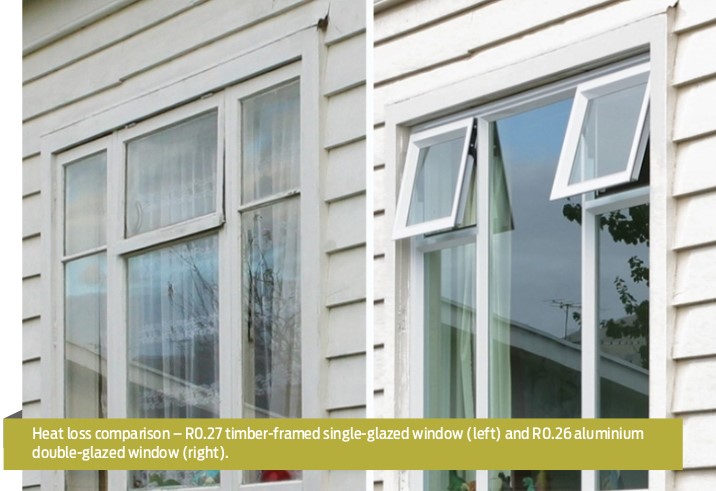Windows may need replacing due to wear and tear or a larger home renovation. Take the opportunity to improve thermal performance while adding aesthetic value, reducing noise and condensation and improving optical properties and the view.
TYPICALLY, WINDOWS comprise about 8–10% of the total area of a dwelling’s thermal envelope, yet they can be responsible for up to 40% of heat losses. This means that, even when closed, old or poorly insulated windows can let the heat out faster than you would imagine.
Installing better windows
Replacing existing windows with ones that perform better can significantly reduce unnecessary heat loss by improving the thermal envelope – reducing the need for heating or cooling and lowering space-conditioning energy costs.
Switching from single to double glazing can improve a home’s airtightness and acoustic insulation while reducing fading and condensation. Upgrading windows can enhance the overall appearance.
Upgrading windows also offers the opportunity to change openable windows to fixed glass that is cheaper and more airtight, reduce the amount of glazing to reduce over-heating or install advanced glazing systems to modify other performance requirements.

Follow the signs and replace
When windows are beyond repair, they need replacing sooner rather than later.
Windows that are worn out, draughty, leaking or hard to open and close need maintenance or replacing. If a house isn’t soundproof, its space-heating energy bills are high, and if it doesn’t have double glazing, it might also be time to upgrade the windows.
What to consider
Even the best-quality windows won’t last forever, although many double-glazed windows will last an average of 20–30 years. The price of new windows varies significantly, so consider the following factors when evaluating the cost of replacing windows.
Actual windows
Evaluate whether all or only some of the windows need to be upgraded. This is also an opportunity to change configurations – the way the windows open or not, their size and how they bring in fresh air, light, noise, heat or a view. In the bathroom, for example, having a side-hung casement opening rather than an awning opening hung near the top will provide far more airflow, helping remove condensation, but it may compromise privacy.
Window layout
Upgrading windows offers the chance to consider their layouts. Are the windows in the right place? Are they the right size for the room? Are the windows in the bedroom too big? Reducing their size may better suit the solar gains and reduce heat losses at the same time. However, you still need to meet the minimum natural ventilation requirements in Building Code clause G4 Ventilation 1.2.2.
The budget
This is simple – get the best windows that the budget allows. Not all windows need to be changed at once, and a room-by-room approach could be taken. They don’t all need the same specifications – for example, windows in a garage can be different to lounge windows.
Also, wooden-framed joinery requires regular maintenance, and this should be included in the budget.
New windows
There are three choices to make when selecting new windows:
- The type of framing – aluminium, thermally broken aluminium, steel, uPVC and timber or fibreglass.
- The type of glazing – double or triple-glazed units with options such as argon gas, low-E coatings, laminates or other optical treatments.
- The type of spacer – from 4 mm aluminium bars to 24 mm thermal spacers.
The framing is as important as the glazing. Double-glazed aluminium windows are not thermally speaking always better than single-glazed timber windows. This is because the aluminium frame is highly conductive and will perform much worse than a timber one, cancelling most of the benefits of having double glazing – particularly in small windows.
The overall performance – R-value – of new windows should always be checked.
Retrofitting double glazing
If new windows are unaffordable, there are cheaper solutions that can be explored. One option is retrofitting secondary glazing to an existing window by:
- installing a temporary plastic film over the glazing
- adding a clear acrylic sheet magnetically fixed to the inside of the existing single glazing.
Another option is to replace single glazing with new insulating glass units (IGU) using the existing joinery – especially with timber windows. This process is clean and quick and, once fitted, unnoticeable.
Installation
Most new windows are installed surface-mounted with the cladding. However, to maximise the benefits of thermally efficient framing, the window should be installed in line with the insulating layer, either rebated as with brick cladding or recessed into the wall. This ensures the continuity of the thermal envelope. BRANZ has recently investigated ways to achieve this – see Testing windows for weathertightness in Build 183.
Did you know?
Have you ever wondered why a small (0.5 m²) double-glazed casement aluminium window and a large (7 m²) double-glazed slider aluminium window have the same reported R-value of 0.26 m²K/W?
That’s because NZS 4218:2009 Thermal insulation, housing and small buildings (Appendix C2) refers to a specific standard window size and configuration (1.8 m wide × 1.5 m high) to represent the thermal performance of a window.
However, the proportions of the framing and glazing do matter. A small window has a greater percentage of frame, dominating the thermal performance, whereas the performance of the glazing will dominate for a large window or door.
To know the true and accurate R-value of each of your windows, ask for a WEERS rating. The WEERS (Window Energy Efficiency Rating System) was developed by BRANZ along with the Window and Glass Association of New Zealand, EECA and MBIE. It is calculated for each glazing and frame unit combining:
- the thermal performance of the frame material
- the thermal performance of the glass or insulating glass units (IGUs)
- the thermal performance of the spacer material in between the glazing units
- the size and shape of the window.
FOR MORE
See Window selection balancing act from Build 169, www.ecodesignadvisor.org.nz and wganz.org.nz/guides/energy-efficiency/.

